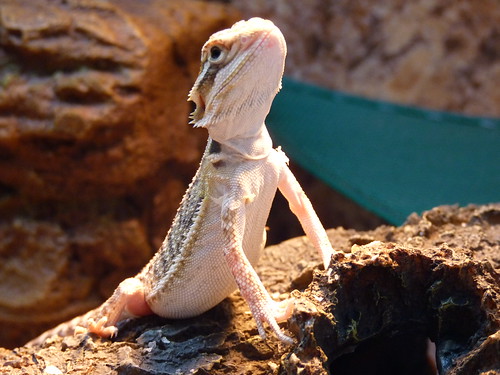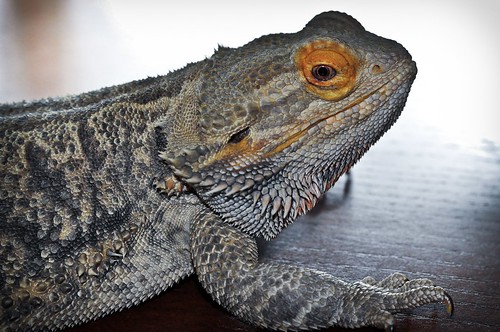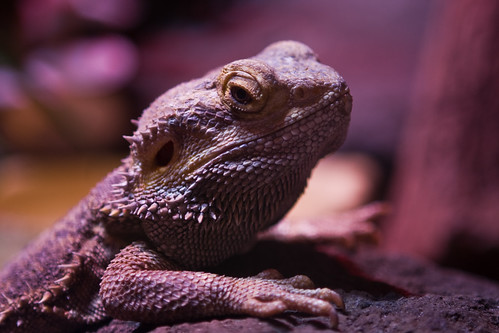To take care of bearded dragon poop, promptly remove it from their enclosure as soon as you spot it. If your bearded dragon is having trouble pooping, you can try the following methods to help them:
- Give them a warm bath for 10-15 minutes, which can help rehydrate their skin and encourage defecation.
- Offer a few drops (1-3) of olive or sunflower oil, which can act as a mild laxative.
- Provide high-fiber fruit purees, such as pumpkin or applesauce, to help with digestion.
If your bearded dragon still doesn’t poop after trying these methods within 5 days, consult a veterinarian. Remember to maintain proper enclosure conditions, including lighting, heating, and humidity, to ensure your bearded dragon’s overall health.
Importance of Proper Poop Care
Proper poop care may seem like a menial task, but it plays a crucial role in maintaining your bearded dragon’s overall health and happiness. Poor poop management can lead to bacterial growth, foul odors, skin irritation, infections, or even death in severe cases.
Additionally, it can negatively impact your home’s environment by creating unpleasant smells or attracting unwanted pests. Regularly monitoring your bearded dragon’s waste helps you keep track of its health status by identifying any sudden changes in its digestion or hydration levels that may require veterinary attention.
Understanding Bearded Dragon Poop
Bearded dragon poop can give you important insights into your pet’s health. As a responsible pet owner, it is essential to be able to recognize what healthy poop looks like and what abnormal stool might indicate. Typically, the size of the poop depends on the size of the bearded dragon.
Younger dragons will have smaller droppings compared to mature adults, which can be as long as six inches or more. The color and texture of feces will vary depending on different factors such as diet, hydration, and overall health status.
The most common color of a healthy bearded dragon’s feces is brown or dark brown with a white urate portion that stands out from the stool. The urate part is usually in small amounts and appears chalky white but can sometimes take on a more yellowish hue if dehydrated or sick.
Factors that can Affect Appearance
A bearded dragon’s diet plays a critical role in its digestive process, affecting the appearance of its feces. If your pet eats too many insects with hard exoskeletons or too much protein without enough fiber content, it may experience constipation or produce dry and hard stools.
Hydration is another crucial aspect that affects the appearance of your bearded dragon’s poop. If your pet does not get enough water or liquids regularly, its fecal matter may appear dry and hard – this can cause impaction in the digestive tract which could lead to severe health issues if left untreated for an extended period.
Common Health Issues Related to Poop
If you notice abnormal appearances such as redness, black spots within droppings (blood), excessive mucus around passing droppings (diarrhea), foul smell emanating from feces, or an absence of droppings altogether, these could be indicators of serious health issues. It is crucial to act quickly and seek professional veterinary guidance if you spot any of these symptoms.
Daily Poop Care Routine
Cleaning and Disinfecting the Enclosure Daily
Keeping your bearded dragon’s enclosure clean is essential to their health and well-being. Daily cleaning helps prevent the growth of harmful bacteria that can cause illness. To clean the enclosure, remove your bearded dragon from the tank and place them in a separate area while you work.
Remove any uneaten food or substrate from the enclosure, as well as any visible poop. Next, use a reptile-safe disinfectant to thoroughly clean all surfaces of the enclosure, including walls, flooring, and decor.
Be sure to rinse everything thoroughly with warm water after applying disinfectant to ensure all traces are removed. Allow everything to air dry completely before returning your bearded dragon to its home.
Spot Cleaning Any Visible Poop Immediately to Prevent Bacterial Growth
Bearded dragons are known for being messy eaters and sometimes poop in their water or on their basking spot. It’s essential that you spot-clean any visible poop immediately to prevent bacterial growth. Use a paper towel or similar tool to remove any solid waste and dispose of it properly.
Removing Any Uneaten Food or Substrate That May Have Been Ingested with The Poop
When bearded dragons eat, they may accidentally ingest some substrate along with their food – this can lead to digestive issues if not promptly addressed. After removing any visible poop from the enclosure, check for any remaining uneaten food or substrate that may have been ingested by your bearded dragon while eating.
Use a feeding dish instead of placing food directly on the substrate bed – this will help reduce the potential ingestion of bedding material by your pet. Remove any uneaten food or substrate by scooping it up with a spoon or similar tool and dispose of it properly.
Weekly Poop Care Routine
Deep cleaning the enclosure once a week to remove any buildup or bacteria
Deep cleaning your bearded dragon’s enclosure is essential for maintaining a healthy and safe environment for your pet. Use a gentle, reptile-safe cleaner to scrub all surfaces within the enclosure. Be sure to remove all substrate and thoroughly clean any accessories or furnishings, including rocks, logs, and hides.
Rinse everything with warm water and allow to air dry before adding fresh substrate. It’s important to note that bleach should never be used in the cleaning process as it can be harmful to your bearded dragon.
Additionally, avoid using any products containing phenols as they can also be toxic. As an added measure of safety, always wash your hands before and after handling anything within the enclosure.
Soaking your bearded dragon in warm water to help soften any stuck feces
Soaking your bearded dragon is an effective way to help loosen any stuck feces that may have built up over time. Fill a shallow dish with warm water that is no deeper than the height of your beardie’s elbows.
Gently place them in the water and let them soak for 10-15 minutes. During this time, monitor them closely to ensure they do not become stressed or agitated.
You may also offer them small amounts of water during their soak if they appear thirsty. After soaking, use a soft-bristled toothbrush or cloth to gently massage their vent area in circular motions while running cool water over it.
Gently wiping your bearded dragon’s vent area with a damp cloth to remove any remaining feces
After soaking and gently massaging the vent area, take a damp cloth or paper towel and carefully wipe away any remaining feces from around their cloaca (the opening where waste is expelled).
Be gentle and avoid rubbing the area, but continue cleaning until there is no visible residue. To prevent further buildup of fecal matter, be sure to clean this area daily during spot cleaning.
If you notice any signs of redness, swelling, or discharge around the vent area, it may be a sign of infection or impaction and you should consult with a veterinarian immediately. With a proper weekly poop care routine, your bearded dragon will enjoy a healthy and happy life.
Preventative Measures
Providing a balanced diet with appropriate fiber content
One of the most important preventative measures when it comes to bearded dragon poop care is providing a balanced diet with appropriate fiber content. Bearded dragons are omnivores, which means that they need both plant and animal matter in their diet to stay healthy.
To ensure that your bearded dragon is getting enough fiber, you should include a variety of leafy greens, vegetables, and fruits in its diet. Some good options include collard greens, mustard greens, kale, carrots, and sweet potatoes.
It’s also important to avoid feeding your bearded dragon too much animal protein or fatty foods. Excessive protein can cause digestive issues such as diarrhea or constipation in bearded dragons.
Additionally, too many fatty foods can lead to obesity or liver disease. Therefore, it’s best to limit the amount of insects and meat that you feed your bearded dragon and focus on feeding them more plant-based foods.
Ensuring proper hydration through regular misting and access to fresh water
Another important preventative measure for proper bearded dragon poop care is ensuring proper hydration through regular misting and access to fresh water. Bearded dragons require high levels of humidity in their environment to help prevent dehydration, especially when they are shedding their skin.
You can maintain the appropriate humidity levels by misting the enclosure with water several times per day or providing a humid hide box filled with damp moss for your bearded dragon to rest in. Additionally, you should make sure that your bearded dragon has access to clean fresh water at all times by placing a shallow dish of water in its enclosure.
Monitoring your bearded dragon for signs of illness or digestive issues
Monitoring your bearded dragon for signs of illness or digestive issues is crucial for preventing any serious health problems related to poop. Some common signs that your bearded dragon may be experiencing digestive issues include not eating, lethargy, bloating, or constipation.
If you notice any of these symptoms or changes in your bearded dragon’s fecal matter, it’s important to consult with a veterinarian who specializes in reptiles as soon as possible. Oftentimes, early treatment can prevent serious health problems and ensure that your bearded dragon remains healthy and happy for years to come.
Conclusion
Proper care and attention to your bearded dragon’s poop is essential for maintaining the health and well-being of your pet. It is important to keep a watchful eye on their digestion and bowel movements, as any irregularities could be indicative of underlying health issues.
By understanding the factors that impact their poop, such as diet, hydration levels, and illness, you can take preventative measures to avoid potential problems. A daily poop care routine should include cleaning and disinfecting the enclosure regularly to prevent any bacterial growth.
Spot-cleaning visible poop immediately can also help avoid further contamination. Removing uneaten food or substrate that may have been ingested with feces is also crucial in keeping your bearded dragon’s environment clean.
It is recommended to establish a weekly routine for more thorough cleaning of the enclosure. Deep cleaning once a week can prevent buildup or bacteria growth inside their living space.
Soaking your bearded dragon in warm water helps soften stuck feces before gently wiping its vent area with a damp cloth. Preventative measures include providing a balanced diet with appropriate fiber content, ensuring proper hydration through regular misting and access to fresh water, as well as monitoring your bearded dragon for signs of illness or digestive issues like constipation or diarrhea.
Taking care of your bearded dragon’s poop may not be glamorous but it is essential for ensuring their overall health and happiness. With proper care routines and preventative measures in place, you can enjoy many happy years with your beloved pet.



